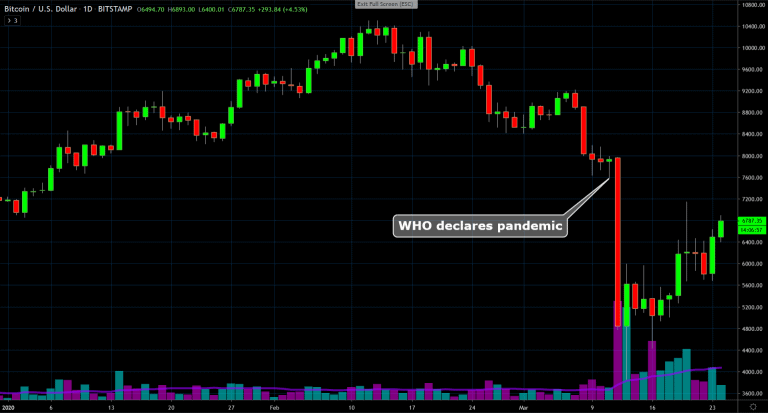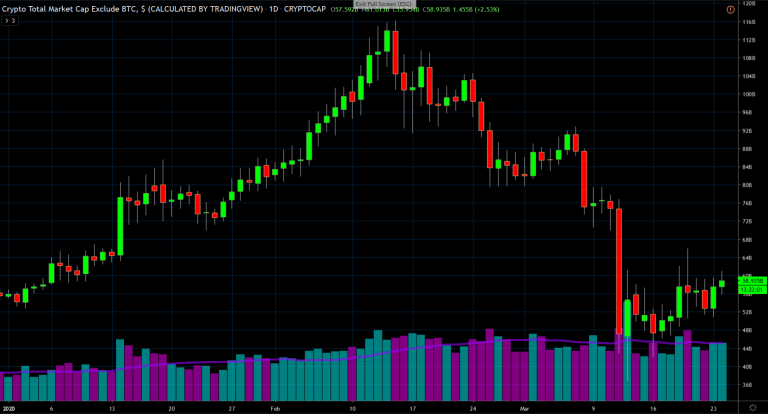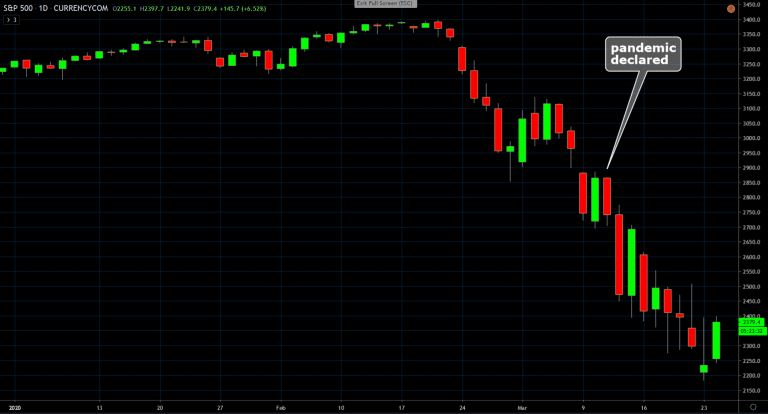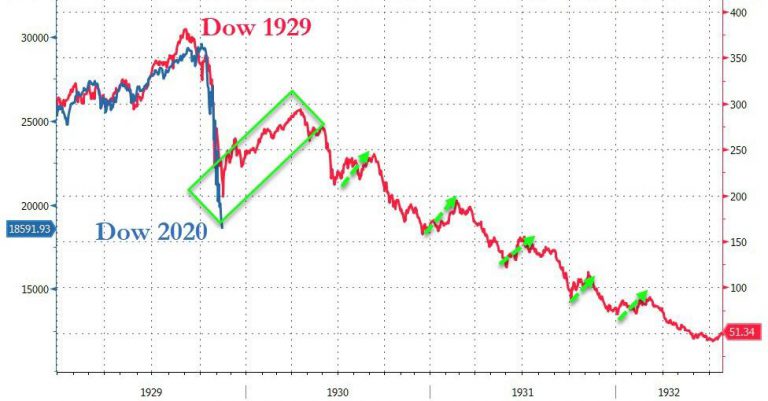With the peak of the Coronavirus pandemic still ahead of us, it’s become apparent that the post-Corona world will be a very different place. The human toll thus far has been catastrophic, but it’s impossible to ignore the financial impact as well: the pandemic has shut down a significant percentage of the world’s economic activity, with many markets posting record losses, and governments and central banks are scrambling to manage the crisis. That devastating impact on financial markets has extended to cryptocurrency as well.
The COVID-19 Bitcoin Crash

Bitcoin’s daily price performance since the start of 2020, chart courtesy of TradingView.com.
Note that stabilization and recovery immediately followed the major drop.
Bitcoin’s crash from $8,000 to a low below $4,000 as the pandemic was declared is far from the Bitcoin halving that market bulls were anticipating. This vicious sell-off was likely a result of institutional whales dumping their speculative crypto positions to cover losses incurred in traditional markets, which collapsed as a result of the global economic shutdown. In fact, even before people rushed to sell Bitcoin, the blockchain reveals abnormally large BTC inflows to major exchanges over a week in advance of the crash, suggesting a coordinated sell-off which was then exacerbated by the liquidation of highly-leveraged long traders.
As usually happens, the rest of the cryptosphere followed Bitcoin’s lead, heading straight down into the dumps as most coins saw even more drastic selloffs. The total value of all coins except Bitcoin fell by around $40 billion before stabilizing close to its early 2020 level, between $50 and $60 billion:

The general crypto market sans BTC has stabilized following the crash but recovery remains slight, indicating that Bitcoin is outperforming the general crypto market.
It’s fair to say that many crypto enthusiasts were disappointed by its price performance in March. Crypto’s reputation as a store of value, uncorrelated to traditional markets, was tarnished. However, as will be explored below, the “safe haven” narrative has yet to reach its ultimate conclusion…
How Cryptocurrency Compares to Traditional Markets
Whereas the crypto crash was short and sharp, the decline in traditional markets was more gradual and prolonged, with signs of support only emerging around the 24th of March:

America’s S&P 500, similar to other major stock indices around the world,
fell 35% from its peak as the grim reality of the COVID-19 disease set in.
Of course, the drop in traditional markets could only be termed “gradual” if compared to crypto markets. The huge and rapid declines across many markets are almost unprecedented in history, comparable only to the Great Crash which heralded the Great Depression of the 1920s:
Courtesy of Zero Hedge: the Dow’s recent price action compared to the start of the Great Depression.
Massive volatility is fairly unremarkable in crypto, with most seasoned individuals and companies well-braced against it. By contrast, traditional markets—already brittle and long-dependent on central bank support—are much less resilient to such hard knocks. Indeed, it seems central banks and governments around the world have already had to intervene massively in various markets to stave off systemic failure.
Predicting Bitcoin: Coronavirus Strengthens the Case for Crypto
The response by central bankers to the looming crisis in the real economy—with factories, offices, and shops around the world either shut or understaffed—has been predictable: print more money. Here are some examples of that money printer in full operation:
- The Trump administration is readying a $2 trillion economic stimulus package.
- In the US, the interest rate has been set to 0% and other governments have also slashed rates.
- Quantitative Easing has resumed in the US (to the tune of $700 billion) and in other countries, often under a different name. In the US, no limits have been set on the purchase of Treasuries by the Fed, which has already bought up over $300 billion worth of American debt.
- New US programs make it possible for the Fed to purchase corporate debt, as the European Central Bank has been doing for some time.
- The Fed can now even purchase certain ETFs, thus becoming openly involved in stock markets, as the Bank of Japan has been for years.
- Debt relief is being granted for mortgage, business and other loans in many countries, and low-interest loans are also being made widely available to struggling companies and individuals.
- Further, and perhaps most shocking of all, from March 26th the reserve requirement for US commercial banks is set to 0%, meaning banks can issue loans (and thereby create new money) without restriction.
Will all these emergency monetary measures—and perhaps even more extreme ones likely to follow—save the real economy? Amid all the travel bans, business shutdowns, civilian lockdowns, and of course the collapse of markets, it remains to be seen whether monetary injections can compensate for real economic activity.
It’s worth keeping in mind that COVID-19 is not the cause of this latest market crash but rather the catalyst for it. The causes can be traced back to the emergency measures undertaken in the last crisis of 2008, and the multiple preceding crises… Most of those measures can be summarized, if rather cynically, as central bankers turning the crank on their money printer ever faster. That newly-printed money feeds a bubble that eventually bursts, requiring yet more printing.
Whereas fiat money is becoming ever more abundant – if not to the average citizen then certainly to his or her financial overlords – hard currencies are increasingly scarce and in-demand. The result can be clearly seen in the gold price of late:

The gold price has staged a strong rebound, almost regaining its pre-crisis level.
It’s clear that gold, the traditional safe-haven and store-of-value asset, is performing its function well during this crisis. In fact, demand for the metal is resulting in an increasing premium on the cost of physical gold over its paper derivative. As gold mines are being shuttered to avoid infection, supply constraints may well lead to further increases in its price and premium. A similar supply decrease looms for Bitcoin, in the form of the upcoming halving. Should gold become unaffordable or unavailable, those who previously shunned Bitcoin may reconsider their position given the similarity of the two asset classes in terms of their limited supply and monetary applications.
Predicting the Impact of Coronavirus on Cryptocurrency
While we can’t predict the long-term effects of COVID-19 on our economies, societies, and individual wellbeing, it does seem a safe bet that the response by central bankers will create the perfect environment for hard money to shine. It’ll certainly be interesting to observe how Bitcoin performs within the context of a recession, or even depression. If Bitcoin continues to outperform traditional markets (with the current exception of precious metals) that could certainly trigger more interest in crypto as an alternative and uninflatable form of money.




